
Astronomical calendar for April 2025
The astronomical calendar for April 2025 in the Northern Hemisphere is an opportunity for observing planetary conjunctions , observing Mercury , a difficult-to-see inner planet, and the well-known Lyrid meteor shower .
Conjunctions of the Moon and planets
The month kicks off on April 2 with a beautiful conjunction of the near-first quarter Moon and the gas giant Jupiter . These two objects are only 5° apart in the sky, visible above the constellation of Taurus. If you have a telescope, take the opportunity to observe Uranus, which appears as a shy pale blue dot at the edge of the Pleiades star cluster. Warning: Do not confuse the star Aldebaran with the planet Jupiter. Aldebaran shines an intense yellow, while Jupiter shines brightly due to the sunlight reflected off its atmosphere.
If you've been dreaming of one day seeing the planet Mars, on Saturday, April 5th, you'll have a beautiful conjunction of the Red Planet with the first-quarter Moon . It's a great time to use your telescope to observe the lunar mountains and valleys, and don't forget to catch a glimpse of Mars, which will pass just 1.7º from the Moon at 9:58 p.m. CEST.
On Sunday, April 13, the full moon arrives . This is the lunar phase most feared by observers. Its intense brightness makes it difficult to observe deep-sky objects such as the Orion Nebula, the Pleiades, and the Andromeda Galaxy. However, observations of the planets Mars and Jupiter are not affected; take advantage of the hours after sunset to observe them on the horizon.
The last conjunction of the month will occur in the early morning of April 29, when the planets Venus and Saturn appear together in the East, just before dawn. The planet Mercury joins them before sunrise, making it difficult to see under these circumstances.
Maximum elongation of Mercury
April 21st is the best time to observe the planet Mercury, which is reaching its greatest western elongation. This phenomenon occurs when Mercury is at its maximum apparent distance from the Sun, and becomes visible in the morning sky shortly before dawn.
Reaching magnitude 0.5 on April 21, Mercury appears as a bright point of light, well positioned above the horizon for optimal viewing. A telescope will reveal that half of the planet's surface is illuminated by sunlight, while the other half remains in shadow.
What telescope can I use to view the planets?
For planetary observation, large-aperture telescopes are recommended, providing high magnification, for example, 150 mm or 200 mm telescopes for up to 400x magnification. The telescope's focal length is also important; focal lengths greater than 1000 mm are preferred.
In our planetary telescope section, we've ranked the best telescopes for all budgets.
Featured Product: Dobsonian Telescope 203mm Aperture / 1200mm Focal Length
Lyrid meteor shower
The Lyrid meteor shower, an annual celestial spectacle, will occur from April 14 to 30, 2025, peaking on the evening of April 23. This event, caused by debris from Comet Thatcher (C/1861 G1), is characterized by fast-moving, bright meteors, with a rate of approximately 10 to 20 meteors per hour under ideal conditions. The Lyrids are known for their sporadic flashes and occasional fireballs, making them one of the most impressive meteor showers of spring. To best enjoy the phenomenon, it is recommended to observe from a dark location, away from light pollution, in the early morning before dawn, when the constellation Lyra, its radiant, is high in the sky.


